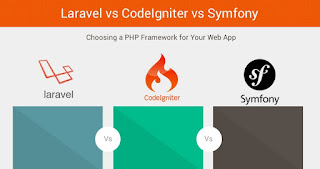Is Laravel the best PHP framework in 2018? Why?

Why Laravel is so popular ?
- Controllers and RESTful Resource Controllers: Resource controllers make it painless to build RESTful controllers around resources. By adding single entry in route.php as
<?php Route::resource('photo', 'PhotoController'); ?> 
- Authentication: Laravel makes implementing authentication very simple. In fact, almost everything is configured for you out of the box. The authentication configuration file is located at config/auth.php, which contains several well-documented options for tweaking the behavior of the authentication services.
- Routing system: Laravel comes with an easy-to-use approach to routing. The route can be triggered on the application with good flexibility and control. To match the URI, a directory is created.
- Unit-testing: Laravel is built with testing in mind. In fact, support for testing with PHPUnit is included out of the box, and a phpunit.xml file is already set up for your application. The framework also ships with convenient helper methods allowing you to expressively test your applications.
- Database: Migrations and Seeding: Migrations are like version control for your database, allowing a team to easily modify and share the application's database schema. Migrations are typically paired with Laravel's schema builder to easily build your application's database schema. Laravel includes a simple method of seeding your database with test data using seed classes. It is an automated process. Database tables can be seeded with default data which can be utilized for application testing or for initial application setup. Laravel is a breath of fresh air. Keep everyone in sync using Laravel's database agnostic migrations and schema builder.
- Eloquent ORM : The Eloquent ORM included with Laravel provides a beautiful, simple ActiveRecord implementation for working with your database. Each database table has a corresponding "Model" which is used to interact with that table. Models allow you to query for data in your tables, as well as insert new records into the table.
- Query Builder : The database query builder provides a convenient, fluent interface to creating and running database queries. It can be used to perform most database operations in your application and works on all supported database systems
- Homestead: Laravel strives to make the entire PHP development experience delightful, including your local development environment. Vagrant provides a simple, elegant way to manage and provision Virtual Machines. Laravel Homestead is an official, pre-packaged Vagrant "box" that provides you a wonderful development environment without requiring you to install PHP, HHVM, a web server, and any other server software on your local machine. No more worrying about messing up your operating system! Vagrant boxes are completely disposable. If something goes wrong, you can destroy and re-create the box in minutes!
- HTTP Middleware : HTTP middleware provide a convenient mechanism for filtering HTTP requests entering your application.
- Support Blade Templates: Blade is the simple, yet powerful templating engine provided with Laravel. Unlike other popular PHP templating engines, Blade does not restrict you from using plain PHP code in your views. All Blade views are compiled into plain PHP code and cached until they are modified, meaning Blade adds essentially zero overhead to your application.
- Artisan Console: Artisan is the name of the command-line interface included with Laravel. It provides a number of helpful commands for your use while developing your application. It is driven by the powerful Symfony Console component.
- Caching: Laravel provides a unified API for various caching systems. Laravel supports popular caching backends like Memcached and Redis out of the box.
- Filesystem / Cloud Storage: Laravel Framework Development Flysystem integration provides simple to use drivers for working with local filesystems, Amazon S3, and Rackspace Cloud Storage. Even better, it's amazingly simple to switch between these storage options as the API remains the same for each system.
- Queue: The Laravel queue service provides a unified API across a variety of different queue back-ends. Queues allow you to defer the processing of a time consuming task, such as sending an e-mail, until a later time which drastically speeds up web requests to your application.
- Very well Documented
- Class autoloading
- Easy to work and begin
- MVC is very flexible
- Fluent syntax
- Modularity
- It is an Open Source

- Laravel is the most famous as it helps to develop a website using a simple and a clean code in a short time. This web application framework has elegant and expressive syntax. Tasks in the web projects such as authentication, routing, sessions, queuing and caching are made easier.
- When compared with other frameworks like codeigniter, Laravel has detailed stack trace. Authorization library, widgets with assets like CSS and JS also form part of this futuristic framework. Libraries and models can be used easily because of the fact that Laravel has Object OrientedLibraries supported with autocomplete feature.
- Future of Laravel Having proved its dominance amongst the PHP frameworks, the future of Laravel is bright enough. Many more developers will switch over to Laravel in the coming future. Given the frameworks numerous features and benefits of using them, Laravel will no doubt continues to be a choice for developers.

Comments
Post a Comment